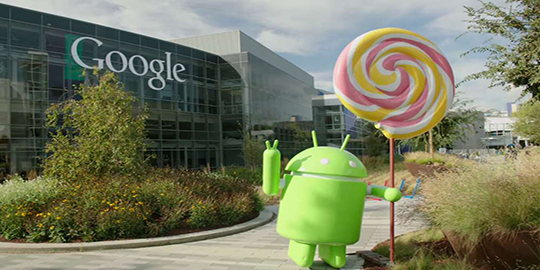
Technology Observatory October 20-26
The Technology Observatory brings you the latest key stories from the technological world:
● The next leap in mobile data transmission: the 24GHz spectrum
● Gmail 5.0 to incorporate users' Yahoo and Outlook mail accounts as well
● Microsoft's smartwatch, compatible with iOS and Android, only weeks away
● iOS 8.1 now available: see what's new here
○ Apple Pay rolls out in the USA: help videos and keys to its possible success
● Apple announces financial results for its fiscal 2014 fourth quarter
● New rumors point to Lenovo's possible acquisition of BlackBerry
● Android 5.0 Lollipop available from November 3
● Google keen to reinvent email with Inbox
● Hello Microsoft Lumia: image of the week
● Not so nice after all: AT&T to block the blank SIM card in the new iPads for users who choose its network
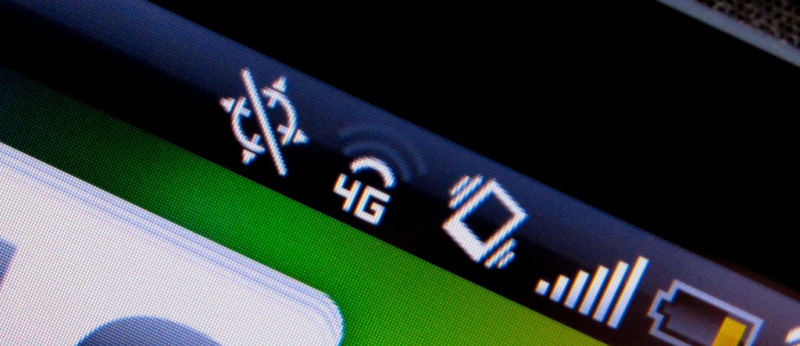
We might soon have gigabit cellular networks that can send gigantic streams of data to our terminals. Although the current technology is the main challenge to access, the U.S. Federal Communications Commission has identified frequencies of 24Ghz and above as being able to provide gigabit or even 10Gbps speed. This is an important milestone and a major leap forward because current mobile networks use frequencies between 600Mhz and 3Ghz, which have a narrower bandwidth but are more appropriate for long-distance data transmission. The general consensus until now was that the higher frequencies of the spectrum, especially above 24GHz, were not suitable for mobile data transmission due to practical limitations, but now it seems that the new mobile technologies, especially those popularly known as 5G, have sufficient potential to support that bandwidth and spectrum. As the FCC points out, it's not a question of replacing the lower frequencies of the spectrum but complementing them with 24GHz and above to provide higher data rates, especially over short distances, so that new standards like the Wi-Fi that uses 60GHz would be able to transmit up to 7Gbps in the same room. Apparently, the problem with this technology is that it would be limited to very short distances, but it would be extremely useful for transmitting vast quantities of data over local wireless networks. These figures look good on paper but we'll have to wait until the technology matures to see the real potential offered by the 24GHz spectrum for short-distance data transmission. Who knows, may be the time will come when downloading a large file to your cell phone will be a matter of seconds.
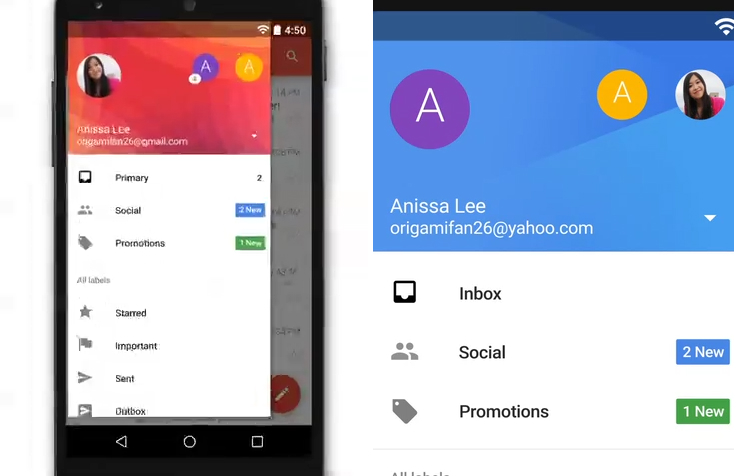
There's nothing new about Google wanting to be everyone's one-stop service. In fact, according to latest rumors doing the rounds, the new Gmail 5.0, the email app for Android, might have its sights set on becoming your sole application for managing mail, as it seems it will be able to support not only Gmail but other accounts like Yahoo and Outlook as well. Accordingly, Gmail 5.0 for Android will be able to work with several of your mail profiles at the same time, so you won't need to swap accounts or use any third-party apps. This is clearly the main benefit, but Gmail 5.0 will also bring various other very interesting updates. For example, improved graphics for many of the elements, such as icons that look more 3D, and features to make the daily workflow more productive. But aside from Outlook and Yahoo, it's still not clear whether Gmail 5.0 will also offer synchronization with Exchange ActiveSync, though that would be great so we certainly hope so. With all these seamlessly integrated mail services, Gmail 5.0 would undoubtedly become the definitive mail manager for Android devices – for millions of users at least. Implementing the service sooner or later would therefore be the most natural next step for Google, but we'll have to wait and see whether they really go ahead with it. When can we expect Gmail 5.0? It's certainly not available yet, although we have some idea of how it works courtesy of the video released by Android Police, who have had a sneak preview. What is certain is that in the coming weeks Gmail 5.0 will reach terminals supported by Lollipop, the biggest system upgrade since Android 4.0 ICS. As for the Gmail version for iOS, not a word has been said, though it's to be hoped that it will include the same improvements as the Android version. We'll be keeping our ears to the ground to bring you the latest news on this front as soon as possible.
According to Forbes, Microsoft's wearable is now ready and after endless rumors and shilly-shallying the company finally looks set to unveil it to the world in the coming weeks. As yet, the actual details about the Microsoft smartwatch are very few and far between, but there's an insistent rumor that it's a passive device that will measure the user's heart beat, and that it will be compatible with the three main operating systems. If Microsoft's wearable does turn out to be compatible with iOS, Android and Windows Phone, and if the device matches its competitors' technical specifications and features, then this could well be the first smartwatch suitable for all users, barring of course more modest devices like Pebble. This is a very interesting move because the strategy that manufacturers have adopted to date has been to maintain the compatibility of their wearables exclusively for the operating system for which they are designed. Hence, the Moto 360 and other Android Wear devices are only compatible with Android terminals, and the Apple Watch, due to arrive at some point in 2015, will only be supported by iPhone, which means that multi-platform compatibility would be a major coup for Microsoft. The most interesting thing about all this is that the smartwatch will apparently use the technology of one of Microsoft's most innovative divisions, Kinetc, so we can expect great things, at least on paper. For example, Microsoft has considerable experience in integrating low-energy sensors, so if they manage to pull off a battery life of more than two days this would be a crucial selling point for people still looking to buy a smartwatch, irrespective of the terminal in their pocket. In this respect, Nadella's appointment as CEO has led to changes in the company that are already impacting on users. And it's very interesting to see how the latest moves from Redmond are clearly targeted at the complete multi-platform: Office in the iPad, Office 365 compatible with all operating services through the web... and now this smartwatch that would mark a new departure from the company's other mobile devices by welcoming iOS and Android.
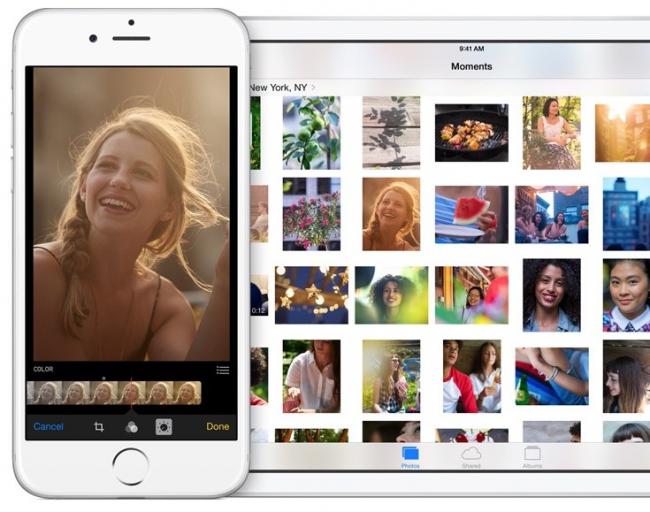
As promised at last Thursday's keynote event, iOS 8.1 is now available as a free software update. This version should fix some of the bugs caused by all the iOS 8 versions that have appeared to date and will include some new features as well. We won't be able to use all of them just yet, but in theory the X.1 version of any iOS will lend greater stability to the system. And if the rumor about several versions being developed simultaneously is true, we shouldn't have to wait too long for future improvements. But let's focus on what's new right now.
● Users in the United States will be able so start utilizing Apple Pay to make payments with their credit cards, but without using the actual cards themselves. How things pan out during the early days of use will be crucial as to whether it becomes a widespread payment option in the future.
● Everyone, irrespective of their country, will have the beta version of the iCloud Photo Library to store all their photographs in one place, which incidentally will be accesible from iCloud.com.
● The classic camera roll is back, though only as a different name for one of the new photo albums.
● If you have a Mac with OS X Yosemite, you'll be able to configure your iPhone as an Internet access point with just one click.
● Again with a Mac, now the receive and make calls function using your iPhone as a 'repeater' has been extended to text messages.
● Finally, as with all updates we should see enhanced performance in every device, especially those where the system was slower (iPhone 4S, iPad 2, etc.). If that's your case, why not use our Comments section to tell us what you think?
Following Apple's release of the iOS 8.1 version, Apple Pay, the company's mobile payment system, has been rolled out in the United States exclusively, which will become the testing ground for the new service. It will therefore join Beats Music and iTunes Radio as exclusive services for users in the United States (and Australia as well in the case of the latter). From now on, owners of an iPhone 6 or iPhone 6 Plus will be able use their terminal to pay for purchases in establishments geared up to accept payments with NFC. And naturally, a number of users have already shared videos on YouTube showing how Apple Pay works in the real world. When Tim Cook gave a demo of the system, he focused on how easy, fast and convenient it was, and now we can see it in action: the customer places the iPhone in range of the reader, confirms the payment with Touch ID, and voilà. The entire process takes just a matter of seconds. Mobile payments are not new, but the solution that Apple has come up with has more chance of succeeding than the other options. Apple made a point of ensuring that all the parties felt truly involved before launching the service. A company can create the best service in the world, but if the user doesn't adopt it all the efforts will have been in vain. So when Apple decided to create its mobile payment platform, it made sure to put the user first. The process had to be simple, convenient and fast to use. Users can add the card associated with their iTunes account or enter the details of another card, either manually or by taking a photo of the card. Filling out the billing details might seem tedious, but you only have to enter them once. With Apple Pay, the new iPhone 6, Touch ID and Passbook are literally all that are between our fingers and the payment button.
Apple has announced its financial results for the last quarter of fiscal year 2014 – Q4 2014 – and the figures are staggering. The quarter just ending for Apple coincides with one of the most important dates of the year for the company, in terms of new products and, naturally, revenues. Early September saw the launch of a new generation of iPhones (iPhone 6 and iPhone 6 Plus), and as in previous years sales have been sky high. In fact, this year the company broke its own record by selling 10 million iPhones during their first weekend on the market. Accordingly, Apple's Q4 2014 revenues have also been sky high,, surpassing those of the same period last year (YoY). This quarter, the giant from Cupertino reported earnings of no less than $42.1 billion, with a net profit of $8.5 billion. And talking of iPhones, sales of Apple's smartphone were astonishing: 39.2 million iPhones were sold in the last fiscal quarter. Overall, the sale of Apple devices during the last quarter of fiscal 2014 can be summarized as follows:
● iPhone: 39.2 million units sold
● iPad: 12.3 million units sold
● Mac: 5.5 million units sold
● iPod: 2.6 million units sold
During the same period last year, Apple sold 35.2 million iPhones, 13.2 million iPads and 4.4 million Macs. The most notable thing about all of this is undoubtedly the decline in tablet sales, while sales of iPhones and computers both grew. Meanwhile, comparing YoY earnings and profit, in Q4 2013 the company earned $37.5 billion and a net profit of $7.5 billion, which this year grew to $42.1 billion and $8.5 billion respectively – a considerable margin, especially in terms of net profit. These results have enabled Apple to announce an operating cash flow of $165 billion. This was undoubtedly a great quarter for Apple, but the company's best fiscal period (in general the same is true for any company specializing in the sale of electronic devices) is yet to come and will coincide with the release of the new iPhone in China, something that is sure to boost sales of this generation of cell phones for Apple.
This is not new: rumors about Lenovo wanting to acquire BlackBerry were doing the rounds all through 2013, with comments and leaks making it practically a fact, but in the end nothing happened and BlackBerry – at the time, RIM – announced its new strategy and investments for the coming months, putting an end to all the speculation. This week there's new information from the Benzinga site, which reports that Lenovo could be interested in acquiring the Canadian company and is willing to pay between $15 and $18 per share. According to some financial analysts, this could amount to approximately $1.5 billion, or nearly half the sum paid for Motorola. The interesting thing about this latest news is that apparently negotiations are well advanced and there might be an official announcement in a matter of days. Even so, until it is confirmed or denied, the rumor has had a major impact on Blackberry's shares, which last Monday closed at $10.30, up by 8.54%. For the moment all this information is pure rumor, but it nonetheless merits due care and attention.
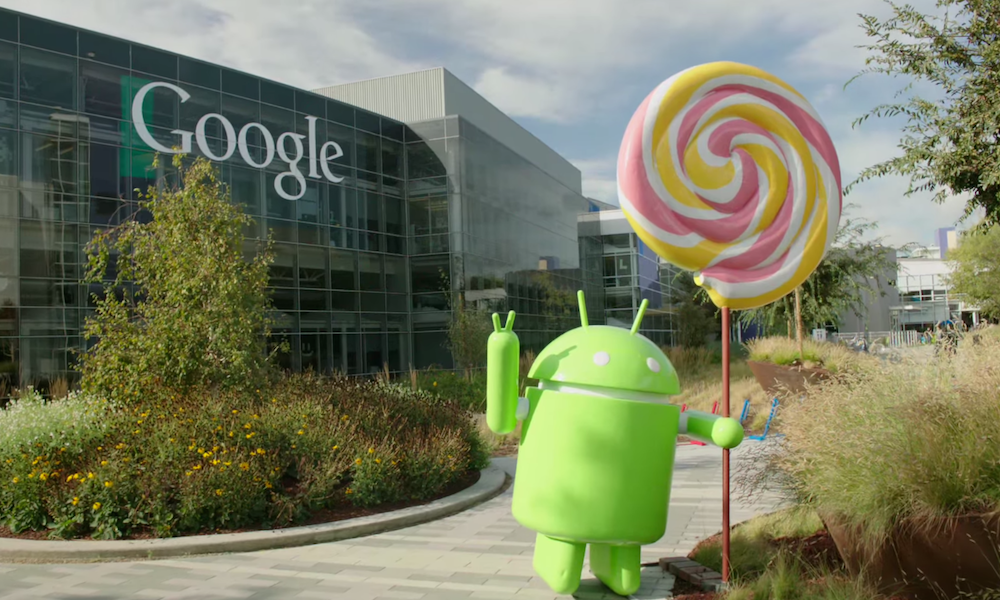
Android 5.0 Lollipop is the next great upgrade. So far we've been able to admire the preview for developers but were waiting for the final OTA to install it in Nexus terminals. Now, thanks to a message in the SDK, we know that it will be available as from November 3. That is the date we're also expecting the various new Nexus terminals to be unveiled, especially the new tablet Nexus 9. The idea is that the Lollipop OTA will also be released the same day for Nexus, and although nothing has been confirmed there is talk that the Nexus 7 (2012 and 2013) and the Nexus 10 will be the first devices to receive Lollipop. The Nexus 5 and Nexus 4 will follow, so put November 3 in your diaries. We'all also have the official release of Google Play for Android TV. It's clearly going to be a busy day when instead of talking about versions for developers we'll finally be able to check out the real thing. If you don't have a Nexus, you'll have to wait for your manufacturer. No doubt Google will make the wait a little less tiresome by releasing multiple upgrades of its apps to Material Design. For those of you who don't have a Nexus terminal, here are the planned dates for the upgrade to Android 5.0 Lollipop.
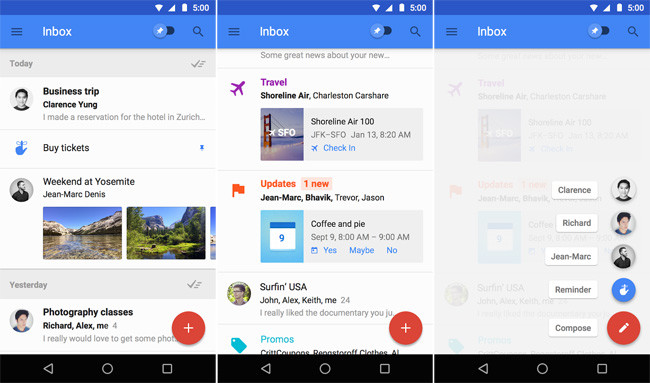
Google has unveiled Inbox, a new application designed to help you manage the chaotic state of your emails. Apparently, they want to reinvent email, and the proposal they've launched is certainly very interesting. The idea is not for Inbox, which will be available for Android, iOS and PC, to replace the company's native Gmail app. Not at all. Rather, it offers an alternative for managing priorities, grouping conversations and related emails, and even reminding you about activities. Inbox is like a powerful version of an email application that includes a series of other functions for boosting the user's productivity. When we talk about managing priorities and content, it's all down to an Inbox function called ‘Highlights’, which makes the most important emails stand out from (tedious) notifications from social media sites and store catalogs. In certain emails it also highlights key information like a flight reservation number, and other such things. Inbox also groups related emails – another very useful feature – for example by putting all your invoices or the messages from a certain person in one place, depending on your settings. Finally, Inbox has a reminder function, which makes the application a type of email-linked diary, all focused on increasing productivity. This means that you can create a reminder for something as basic as answering an email or booking a hotel room, and the application will remind you, even supplying information like the phone number and email address of the hotel you entered, all courtesy of Google technology and Google Now. We've already seen Google include labels and categories in Gmail as a type of alternative for trying to sort and manage all emails received, but with Inbox the leap is even greater. In short, it's a very interesting application for managing email that arrives as an alternative to the native Gmail, not a replacement. For now, Inbox is available by invitation only, as is usually the case with new Google products, and you can request one by writing to inbox@google.com.
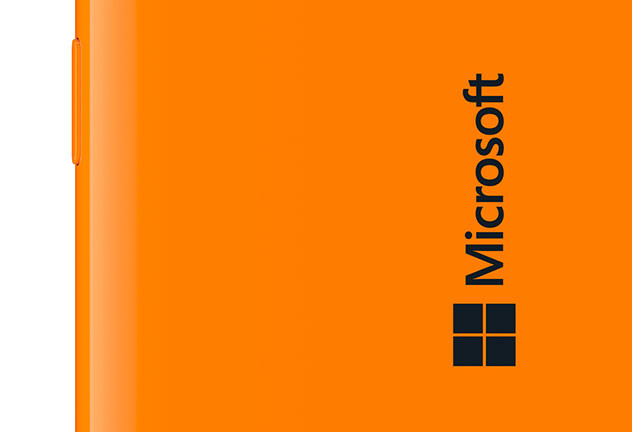
As expected, Microsoft has officially announced the new brand for Lumia devices. Logic has finally won the day and the legendary Nokia will no longer (though you never know) appear on smartphone cases. The Nokia Lumia will be called Microsoft Lumia in future models. With a "Say hello to Microsoft Lumia", the Redmond-based company announced the change of brand we'd all been waiting for after the countless little modifications they've implemented on their websites in recent months. Thus, the Nokia logos will disappear from selected ranges and be replaced by Microsoft logos and squares. This article in the Nokia blogs explains the transition and adds that the first Microsoft Lumia will arrive "soon", without specifying the date. Nokia is not only about high-end products, and in fact a large proportion of its business has traditionally been entry-level products. Microsoft will preserve the Nokia brand in entry-level phones, such as the recent Nokia 130, and they say it won't be the last. Although Microsoft will continue to release new Nokia phones, its Lumia smartphone business will be called Microsoft Lumia from now on. Nokia Lumia will soon become a thing of the past. We'll have to wait and see how this change of brand affects revenues, which as you will remember were not too bad in the latest financial results announced, with 9.3 million Lumia phones sold.
When Apple unveiled its new iPads last week, we said the greatest innovation that the company had introduced was the blank SIM card. Although not a new invention, it was the first time a major manufacturer had adopted it, allowing users to choose their own operator and plan without having to change their SIM card. Initially, three American operators (AT&T, T-Mobile and Sprint) and one British one (Everything Everywhere) signed up to the initiative, though it will undoubtedly attract more operators from more countries and, most notably, will encourage other manufacturers to introduce blank SIM cards. But now we have the first bad news: AT&T is blocking the SIM card if users take out a plan with them. A blank SIM card. There's been a great deal of talk about this in the past but until now it had never really been put into practice. Being able to swap operators without changing the SIM card offers nothing but benefits for users, but making it so easy could revolutionize the telephony market completely. And it's that fear about swapping operators so easily that seems to have gripped AT&T, one of the U.S. operators that offers plans through the blank SIM card in the new iPads but which will block the card in Apple tablets for users who select its network. Users will be able to select plans and swap between T-Mobile, Sprint and EE freely, but once they've chosen AT&T they won't be able to swap to another operator with the same card. In declarations to Re/Code, a spokesperson for the operator defended the company's policy, arguing that the iPad will still be free because if users wants to swap to another operator after choosing AT&T, they will simply have to obtain another SIM card from an Apple Store. A hole in a very interesting initiative, as the option of swapping operators directly from an iPad greatly facilitates the choice for users, both for domestic use and for obtaining a local rate when traveling overseas.
